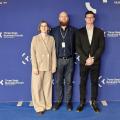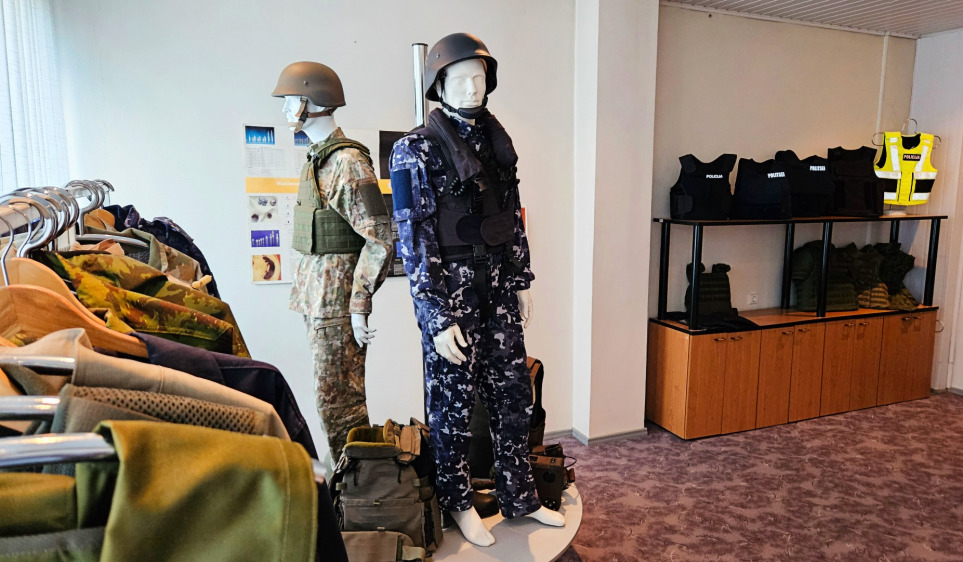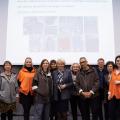Paieška
2024. 01. 18
-
Shots echoing and future garments being made: a walk through the FTMC Department of Textile Technologies
In November, FTMC announced the launch of its smart cooling and warming vest. This piece of clothing for extreme conditions is one of the first Lithuanian inventions to receive a European Unitary Patent.
But this is far from all that has been developed by researchers at the Department of Textile Technologies of FTMC for decades. Scientists, engineers, technicians and other professionals are doing exciting work here that is being turned into practical items. The laboratories are also used for unique experiments on various fabrics.
Let's take a virtual tour and find out more.
From zero in a pocket to millions of orders
A tall old building stands on Demokratų Street in Kaunas, close to the Neris River. This is the Department of Textile Technologies of FTMC. Its history dates back to 1960, when the Lithuanian Textile Industry Research Institute was established. Initially, its scientists worked on research and development of technologies related to artificial fibre acetate and triacetate yarns.
Two decades later, the development and production of materials for the USSR space industry began: thermo-insulating panels for the hull of the Buran spacecraft, materials for cosmonauts' spacesuits, etc. When Lithuania regained its independence, this institution became the Lithuanian Textile Institute (LTI), and in 2012 it was merged into FTMC and renamed the Department of Textile Technologies.
The building is in need of renovation, many of rooms are empty and some are already occupied by other companies. However, some of the walls look truly unique - they are decorated with a thematic interior made of ceramics, reminiscent of threads and fabrics, created by artist Aldona Keturakienė in 1987.

(Photo: FTMC)
Dr. Aušra Abraitienė, the former long-time head of LTI, recalls the 1990s and the first steps of the institution. "It was a huge challenge. But we thought: well, okay, we have arms, legs and brains - we have to do something. Since the Soviet era, there has been a vogue for setting up experimental bases - 'scientific production associations' - at scientific institutions. The idea came to us to use that base to produce our own unique products. Of course, the base was incomplete and lacked a lot of equipment."
The leader applied to the public authorities for a loan with a state guarantee and received it... in Swiss francs. According to Aušra, this helped a lot - LTI bought a complete line of state-of-the-art textile production equipment.
The team set out with the goal (which has remained the same to this day) of creating unconventional textile products - as there were already a lot of companies producing conventional clothing (jackets, trousers, etc.). Something specific was needed.
"We have launched a range of technical clothing to protect workers from microbiology, flames and other hazards. We entered and won tenders from public authorities, and that was the first money. I also went to all the international exhibitions wherever I could. My colleagues put our products in a bag for me and I take them to show them off. Little by little, the experimental base started to 'feed us'," recalls Abraitienė.
She and her colleagues then started making fabrics for bulletproof vests. It was a product with the highest added value: millions of orders starting in 1992 are still being placed today, and the fabrics continue to be improved. This was followed by the development of garments for the Lithuanian army and other needs, which we will talk about soon.

(Dr. Ingrida Padleckienė and Dr. Aušra Abraitienė, wearing an eco-friendly garment made by FTMC and designer S. Gandžumianas. Photo: FTMC)
Today, the Department of Textile Technologies employs 45 specialists, including 10 researchers. The main focus is on the combination of textile and chemical processes, the development of new fabrics, special functional coatings to give new properties to fabrics, and the development of environmentally friendly textile finishing processes.
To add a few more numbers: in just over 10 years of being part of FTMC, the team has completed 7 international and 9 national research projects, written 50 publications, and obtained 3 patents for inventions. And the Department has earned €17 million over the decade for its various services and products. Research and experiments are thus converted into real, tangible garments or items of clothing.
"We never finish our work just by saying, 'OK, it works in theory, great'. No, for us it goes all the way to the prototype. And in some cases, such as with the Armed Forces, to mass production (which we develop together with partners). Here, one and a half hundred thousand Lithuanian soldiers are already wearing or have worn our uniforms," says Aušra happily.
Alert clothing, warming threads and the greenest garment
First, we visit the exhibition dedicated to the various products created here. Dr. Ingrida Padleckienė, a researcher, invites us to approach the mannequins. One of them is wearing clothing designed for professionals who work in extreme heat for long periods of time, such as road workers or furnace workers.
"A system of sensors embedded in the clothing tracks the parameters of the human body and transmits them to a central computer. For example, sitting in a van, you can monitor the data of your dozen or so employees and see: aha, this one's pulse is dropping, this one is giving you other warning signals, and so on," says Ingrida.
The sensors are positioned close to the heart, shoulders, abdomen and other important parts of the body: "We consulted with doctors to find out where the critical points of the body are. It's not a big deal if your arm gets overheated, but it will be much worse if your liver or kidneys are at risk."
When the system detects a health hazard, audible, light and vibrating alarms are triggered. The idea is that if you are working in a noisy environment, you may not hear the warning squeak; but if a red signal lights up in your clothing, other colleagues are likely to have noticed it. After all, even if there are no other workers around, you will be aware of the danger because your back will vibrate, which also means it's time to retreat to a cooler place.

(Dr. Ingrida Padleckienė. Photo: FTMC)
It is possible for a person to disable the warning signals themselves - but only a limited number of times: "The first time, the second one you can still turn it off (although everything will be visible on the central computer), the third time you can't, you'll have to leave," says Ingrida.
The technology was developed as part of a European project, and has been tested in real working conditions by road workers in Italy, by steel workers in the Netherlands, and by employees of Palemono Keramika in Lithuania.
"At that time, in 2018, we went to glass factory Panevėžio Stiklas for filming, to show the outfits. They were interested in this innovation because during certain periods, employees have to clean the furnaces. They used to do it like this: a person goes into the furnace with a rope tied around him, which he sometimes pulls. It was a sign that all was well," smiles I. Padleckienė.
Researchers' inventions save not only the heat, but also the cold. Here's another mannequin wearing a warming T-shirt. It looks normal, but the garment's threads carry an electric current that provides heat to the body. This can be useful for athletes who are waiting for a match after warming up - or if they take a break during the game (for example, a basketball player resting on the bench). Warm-up shirts help to keep muscles warm and prevent sweaty bodies from getting too cold.
According to Ingrida, it is also suitable for climbing mountains and other places where the weather is extremely cold: "Again, we consulted with the medics and made the shirt warm the back, shoulders and important internal organs. A constant temperature is maintained at all times, which can be set to a maximum of 38 degrees. In this heat, the battery lasts for 4 hours and all the data can be monitored on your phone or computer."

(Dr. Audronė Sankauskaitė with examples of organic fabrics. Photo: FTMC)
On the other side of the exhibition are eco-friendly leisurewear, a collection created by the Department of Textile Technologies in collaboration with designer Seržas Gandžumianas. Scientists have developed materials for clothing from hemp and wool, and replaced polyester with polylactide, the greenest chemical fibre. Dr Audronė Sankauskaitė, a chemist involved in the project, explains:
"Polylactide is a biodegradable fibre created from starch-rich plant waste such as corn. It breaks down when composted at temperatures between 50 and 60 degrees. Polylactide is considered to be the fibre of the future because, like polyester, it has a number of good qualities, such as wrinkle-free properties, form stability and other advantages."
Another part of the exhibition is a showcase where you can see textiles once made for space and... smart socks, patented in the current period, which not only regulate heat and humidity, but also repel ticks and other nuisance insects.
To avoid detection by radar
The Department not only develops smart solutions itself, but also carries out orders from Lithuanian and foreign companies for experiments and trials. Every day, the FTMC team in Kaunas receives about 10 requests and performs over 200 orders per year.
Dr. Vitalija Rubežienė, Head of the Laboratory forTesting and Certification of Textiles, shows one of the laboratories with equipment for spectral analysis. "Colour is very important in textiles. If one roll is different from another and the garment is sewn, one sleeve will look one shade and the other another. The colour difference is a significant parameter, so we check it. Especially for protective clothing, there are a lot of requirements related to colour," explains Vitalija.
Companies often send samples of fabrics and ask for an assessment of the colour deviation from the required standard. The technical requirements specify the percentage of colour difference between one specimen and another. If the sample is within the specified percentage, all is well, but if the difference is too big, it is a loss for the manufacturer. The laboratory therefore uses reliable instruments that show these parameters down to the smallest detail; the fabric is attached to the machine and the computer screen shows all the data.

(Dr. Sandra Varnaitė-Žuravliova in front of a device that measures fabric colours. Photo: FTMC)
Sometimes the State Consumer Rights Protection Authority sends the clothes, because companies sometimes like to cheat and lie about the composition of the clothes. This can also be detected by FTMC staff.
Another is called an "artificial sun". It uses a xenon discharge lamp that emits light in a similar spectrum to the Sun. This helps to learn about the lightfastness of the fabric. "We rate it on an 8-point system. An 8 means 'very good', but there are hardly any garments like this," smiles V. Rubežienė.
She also shows some of the fabrics used for the clothing of Lithuanian soldiers. FTMC and its foreign partners have been working for years on the development of so-called adaptive camouflage - a soldier's clothing that helps to better disguise not only during the day, but also at night when the enemy uses infrared binoculars. And that's not all: Lithuanian scientists are working on a special clothing coating to prevent radar from picking up the soldier.
The first international project has been a success, with trials of the garments at test sites in France, Portugal and Sweden. The experiments showed that the uniform with an anti-radar layer almost halved the radar cross-section - the parameter that determines radar detectability - compared to the common uniform.
FTMC team is working on a new project under the European Defence Fund's ACROSS (Adaptive Camouflage for Soldiers and Vehicles) programme.
"We will improve ground systems - both military and vehicle adaptive camouflage. The project involves partners from 9 countries. Our main task is to make sure that radars do not 'see' a soldier or a vehicle", says Vitalija.

(Dr. Vitalija Rubežienė and examples of fabrics for soldiers. Photo: FTMC)
More comfortable uniforms for soldiers
Continuing this theme, we find ourselves in another room of the exhibition, where various military uniforms, bulletproof vests, helmets and military boots are displayed. When the Lithuanian Armed Forces were re-established, LTI immediately started working with them.
"The very first uniforms of our soldiers were pure cotton, they tore easily and quickly lost their colours when worn. Cooperation with NATO partners has helped to address this problem, opening a new chapter in the history of modern uniforms. The newly developed fabric had the good feel of cotton, was soft and pleasant to wear against the body, but at the same time strong," says A. Abraitienė.
The fabric was available in several colours, both for field and naval uniforms. For the latter, FTMC developed a new colour scheme and camouflage design. "We went to Klaipėda, on board the ship, we combined the colours and reinforced the fabric to make it more resistant to sea conditions," recalls Laima Lenkauskaitė, Chief Engineer of the Department.
"We still regret that the Lithuanian Armed Forces abandoned this innovation because of market conditions," adds Dr. Aušra Abraitienė.

(Laima Lenkauskaitė and Dr. Diana Kubilienė in front of the outfits designed for soldiers. Photo: FTMC)
On the shelf is a large number of bulletproof vests designed over several decades for the army and police (Lithuanian and Estonian). Among the newest is a vest that covers 80% of vital organs. Another exhibit is a bulletproof vest that does not drown. "When you pull the cord, a balloon inflates inside the vest, which can hold 180 kilograms in water," says Laima.
And, of course, there is the multifunctional vest, mentioned at the beginning and featured in the media, which warms and cools the body. This type of garment is designed for industrial workers, road workers (when it is very hot) or the soldiers (for example, in the cold trenches).
A shooting gallery in a research institute? Definitely yes
The team of the Department of Textile Technologies are the only specialists in Lithuania who create original Lithuanian armour vests: they make a prototype from A to (almost) Z, and their business partners turn it into mass production. "The whole "brains" of the bulletproof vest is contained in the inner layer, which withstands a bullet. This is our know-how" says Aušra Abraitienė.
The development and refinement of these vests is currently focused on the moulding of composites for ballistic panels. A vacuum membrane press is used. The specimen is placed on a mould, sealed with a 'lid', the inside is heated, the vacuum mode is activated, and the membrane is pressed on top and tensioned. When everything has cooled down and the press is opened, the layers take the required shape.

(A shooting device ready for a bulletproof vest test. Photo: FTMC)
And where are these vests tested? Again, in FTMC building in Kaunas! In one of the rooms, there is a firing device that resembles a metal sash with a tightened pipe. In the adjacent room, a running platform is mounted on rails. It has a plasticine body, which simulates a human body, and an armoured vest strapped to the base. The platform rises, the barrel is aimed, the gun is cocked and the timer is set. Then we all leave the room, put on our headphones, and there's a BANG!
Returnees are greeted by the smell of gunpowder. "When you work here, you're all smelly", laughs technician Vytis Aleksiejūnas. The shot knocked out a 22 mm hole in a plasticine - it's OK, it means the person will survive, at worst, one other bone will be broken. But the bullet itself is lodged in the vest. The product passed the test.
By the way, military helmets are also hanging in the shooting range: Lithuanian partners from Germany keep sending their helmets to test their strength.
Lengthening, stretching, curling and... burning
Let's take a look at other laboratories that are already testing the physico-mechanical properties of tissues. Future garments are tested with special instruments to determine how resistant they will be to abrasion, pilling, tearing, creasing, folding and other factors. One machine rotates the cubes in which the samples are placed to test their resistance to pilling and abrasion.
Engineer Lina Jurgelionytė presents another device - a stretching machine. A piece of cloth is inserted, which is pulled and then torn. Every few seconds you can hear a click and the computer screen displays graphs.

(Lina Jurgelionytė and a laboratory tissue stretching machine. Photo: FTMC)
The next test is the change in dimensions after washing. Engineer Dalė Šimkevičienė stands next to expensive washing machines and powder you can't buy in shops. By washing a sample, you can see how it shrinks and what the material will look like. For example, this is how you check whether protective clothing meets the certificates that say the product can withstand, e.g., 50 washes. In this case, the garment is washed, dried and washed again for the full 50 times - and then its final properties are tested.

(Dalė Šimkevičienė and laboratory washing machines. Photo: FTMC)
The laboratory machines also simulate other everyday situations that affect the colour of the material - artificial sweat, humidity, alkali stains, etc.
It is also important that protective clothing is coated with the right material and is flame retardant. So what does FTMC team do? Burn them, of course! A piece of cloth is placed in a laboratory "closet" and for a few seconds the cloth is exposed to the flame. The result: a hole appears, and the area around it turns black, but that is all. The fire did not spread. At that point, the normal fabric would burn instantly.
Extremely practical chemistry
How can chemistry help textiles? This is one of the most important tasks of the Department. Another laboratory is dedicated to this, where coatings are formed on materials, nanoparticles are introduced to give the future garment a range of useful properties, and dry lamination, the bonding of materials using heat and certain adhesives, takes place.
There is also an infrared dyeing machine, a shaker or an ultrasonic bath. There is also a plasma machine: nitrogen or oxygen gases are used to clean and etch the surface, make it more active and help other materials to absorb better.
And the latest challenge for the lab is to develop a colorimetric sensor to change the colour of fabric. According to A. Abraitienė, this is a technologically difficult task, but progress is being made.
And the idea is: "Ignalina Nuclear Power Plant is right here. Let's imagine that there is a radiation leak. In order to be detected by public authorities, a certain amount of radiation has to be released into the environment, at a certain level. And what is an ordinary person to do until then? If he has a small piece of our fabric and sticks a sticker on it, he will immediately notice that it has changed colour. That will be a warning that the danger has begun. That's the express method."

(Scientific-experimental product design laboratory. Photo: FTMC)
"We could have orienteering games here," say the staff, laughing as they walk down the long corridors. The last stop on the tour is the huge scientific-experimental product design laboratory, where knitting machines and looms are set up. Here, the final touches are being put to the prototypes of the garments, which will then be tested in practice under everyday conditions.
So, while the building on Demokratų Street may not stand out on the outside, there is real life and great ideas inside. Talented scientists, engineers and other staff are doing unique work that benefits society - all of which we will sooner or later learn about.
Written by Simonas Bendžius
Susiję:

2024. 06. 12
-
J. Pupeikė, a PhD student at FTMC, developing e-textiles, is the author of the best poster presentation at the international event
Materials developed by FTMC are flexible, washable and abrasion-resistant, which is crucial for e-textiles.

2024. 05. 15
-
Creating a new generation of eco-friendly textile: FTMC strengthens cooperation with the Lithuanian Apparel and Textile Industry Association
We will look for effective ways to produce a new generation of fabrics that are easier to recycle - or do not need to be recycled at all.

2024. 04. 12
-
FTMC innovation experts at the Three Seas Initiative event
They presented technologies and products developed at our Center for both civilian and military use.

